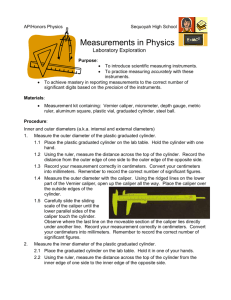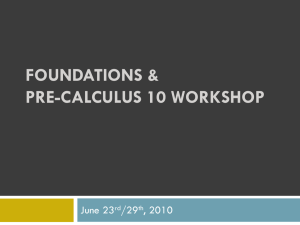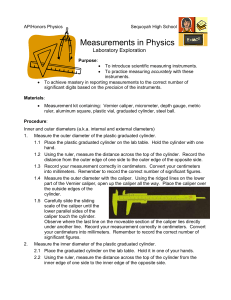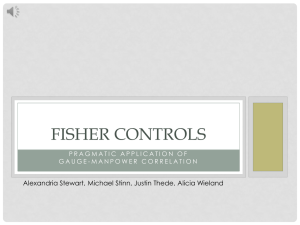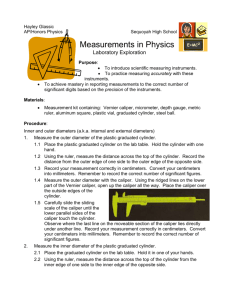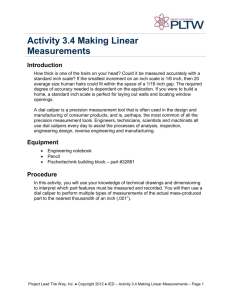Measurements in Physics
advertisement
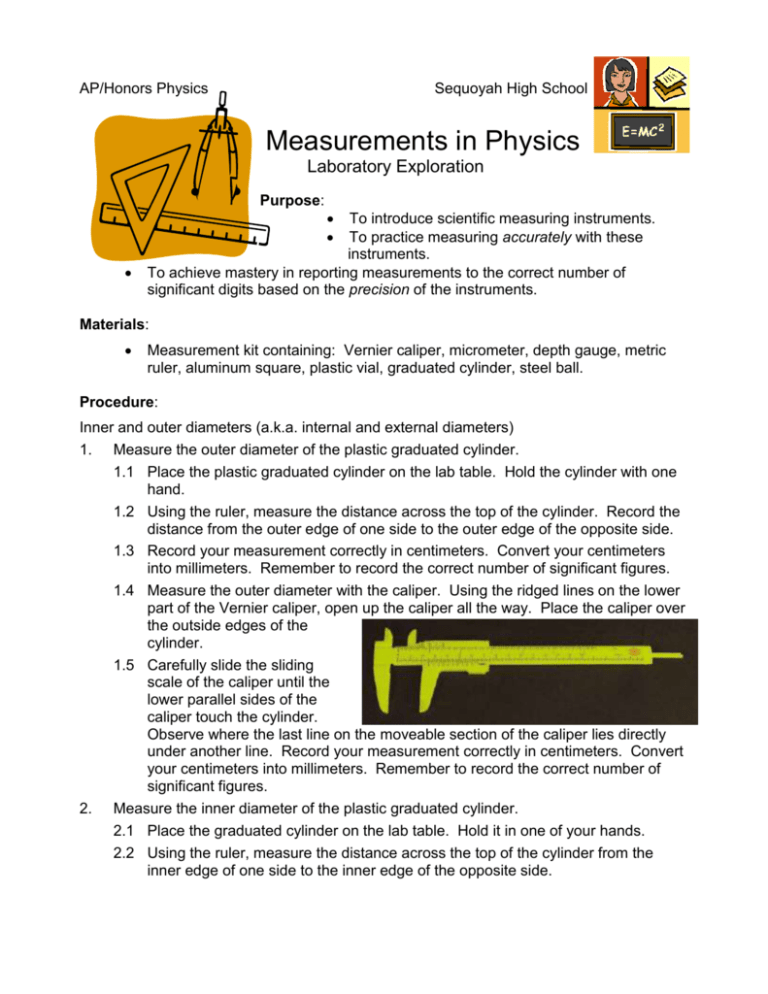
AP/Honors Physics Sequoyah High School Measurements in Physics Laboratory Exploration Purpose: To introduce scientific measuring instruments. To practice measuring accurately with these instruments. To achieve mastery in reporting measurements to the correct number of significant digits based on the precision of the instruments. Materials: Measurement kit containing: Vernier caliper, micrometer, depth gauge, metric ruler, aluminum square, plastic vial, graduated cylinder, steel ball. Procedure: Inner and outer diameters (a.k.a. internal and external diameters) 1. Measure the outer diameter of the plastic graduated cylinder. 1.1 Place the plastic graduated cylinder on the lab table. Hold the cylinder with one hand. 1.2 Using the ruler, measure the distance across the top of the cylinder. Record the distance from the outer edge of one side to the outer edge of the opposite side. 1.3 Record your measurement correctly in centimeters. Convert your centimeters into millimeters. Remember to record the correct number of significant figures. 1.4 Measure the outer diameter with the caliper. Using the ridged lines on the lower part of the Vernier caliper, open up the caliper all the way. Place the caliper over the outside edges of the cylinder. 1.5 Carefully slide the sliding scale of the caliper until the lower parallel sides of the caliper touch the cylinder. Observe where the last line on the moveable section of the caliper lies directly under another line. Record your measurement correctly in centimeters. Convert your centimeters into millimeters. Remember to record the correct number of significant figures. 2. Measure the inner diameter of the plastic graduated cylinder. 2.1 Place the graduated cylinder on the lab table. Hold it in one of your hands. 2.2 Using the ruler, measure the distance across the top of the cylinder from the inner edge of one side to the inner edge of the opposite side. AP/Honors Physics Measurements in Physics 3. Sequoyah High School Page 2 2.3 Record your measurement correctly in centimeters. Convert your centimeters into millimeters. Remember to record the correct number of significant figures. 2.4 Measure the inner diameter of the cylinder with the caliper. Invert the caliper so the upper part of the caliper is inserted into the inside of the cylinder. Place your thumb on the ridged section. Slowly move the caliper until the parallel parts for the internal measurement are touching the sides of the cylinder. 2.5 Carefully observe the inside bottom of the caliper to take your measurement in centimeters. Observe the last line of the bottom of the moveable part of the caliper to determine the internal measurement of the cylinder. 2.6 Convert your centimeters into millimeters. Remember to record the correct number of significant figures. Calculating circumference and volume 3.1 Determine the circumference of the cylinder based on the outer diameter obtained from the ruler in centimeters. 3.2 Repeat the calculation using the diameter obtained from the caliper in centimeters. Record your answers in the correct number of significant figures. 3.3 Determine the depth of the cylinder using the depth gauge accessory on the caliper. Record your answer in centimeters using the correct number of significant figures. 3.4 Calculate the total volume of the cylinder in cubic centimeters using the measurements taken with the ruler and with the measurements taken with the caliper and depth gauge. Record your answer with the correct number of significant figures. Length, Width, Area and Volume 4. Measure the length, width and height. 4.1 Obtain the aluminum square. Using the ruler, measure and record the length, width and height of the aluminum square. Record your answer in centimeters using the correct number of significant figures. 4.2 Calculate and record the area of the face of the aluminum square. Calculate and record the volume of the aluminum square. Record all data using the correct number of significant figures. width length height AP/Honors Physics Measurements in Physics Sequoyah High School Page 3 4.3 Measure and record the length, width and height measurements with the caliper. Calculate and record the area of the face of the aluminum square. Calculate and record the volume of the aluminum square. Record all data using the correct number of significant figures. 5. Obtain measurements with a micrometer. 5.1 Remove the micrometer from the measurement kit. Your micrometer is a precise instrument and should never be over tightened. Place the handle of the cylinder in one hand, and with the other hand, hold the rounded bottom. Turn the revolving barrel counterclockwise. Observe the units of measurement on the rounded shaft. Turn the moveable barrel counterclockwise or clockwise until the 0 line is perfectly horizontal to the horizontal line. Note that one turn of the barrel represents one millimeter. 5.2 Carefully turn the micrometer in a counterclockwise direction until it is opened wider than the height of the aluminum square. Carefully slide the aluminum square into the micrometer. Turn the barrel clockwise until it is touches the aluminum square. Turn the knurled knob on the end of the micrometer one “click” to achieve the desired tightness for measurement – remember: do not over tighten. Record the height of the aluminum square with the correct number of significant figures. 5.3 Calculate the area of the face and volume of the square using the caliper length and width measurements and the micrometer height measurement. Record the area and volume using the correct number of significant figures. Challenge (optional, as time allows): 6. Measure and record the volume of pulp required to manufacture a sheet of notebook paper. Record your measurements and calculations using the correct number of significant figures. Analysis: 1. Compare and contrast accuracy and precision. Consider how one could improve the accuracy of a measurement? the precision of a measurement? Accuracy is the closeness to the correct values where precision is the closeness together of the data you gathered. Accuracy can be improved by using the most sensitive measurement instrument available to you, and precision can be increased by using the same instrument for all of the measurements. AP/Honors Physics Measurements in Physics 2. Sequoyah High School Page 4 Compare the number of significant figures in the calculations and measurements taken with the ruler to the measurements taken with the caliper and micrometer. Discuss the differences in precision of these instruments. The ruler is the least precise because it can only go to 1 sig. fig. where as the caliper can go to 2 sig. figs. and the micrometer can go to 3 sig. figs. The ruler is also the least precise the caliper next precise and the micrometer the most precise for these same reasons. 3. Compare your measurements and calculations with those of a classmate. Are they the same? Discuss sources of error in the accuracy of the measurements. No they are not quite the same due to the last sig. fig. where you have to determine where to put the measurement when it’s between marks. The error in accuracy of these measurements is due mostly to how carefully we read the instrument. 4. Which instrument is more precise, the metric ruler, micrometer or caliper? the ruler is least precise, the caliper is next precise, and the micrometer is the most precise. AP/Honors Physics Measurements in Physics Sequoyah High School Page 5 Sample Data Table (you may use this one or create your own): Graduated Cylinder Dimension Metric ruler Caliper Outer diameter 1.6 cm 1.51 cm 16 mm 15.1 mm 1.3 cm 1.33 cm 13 mm 13.3 mm Circumference 5 cm 4.71 cm Depth -- cm 10.31 cm 207.3 cm3 187.84 cm3 Inner diameter Volume Aluminum Square Dimension Metric ruler Micrometer Caliper length 2.4 cm 2.42 cm 24.20mm width 2.4 cm 2.42 cm ………………………………………. height 0.4 cm 0.43 cm ………………………………………. 15.4 cm2 5.856 cm2 585.64mm2 2.3 cm3 2.518 cm3 251.825mm3 Area Volume
